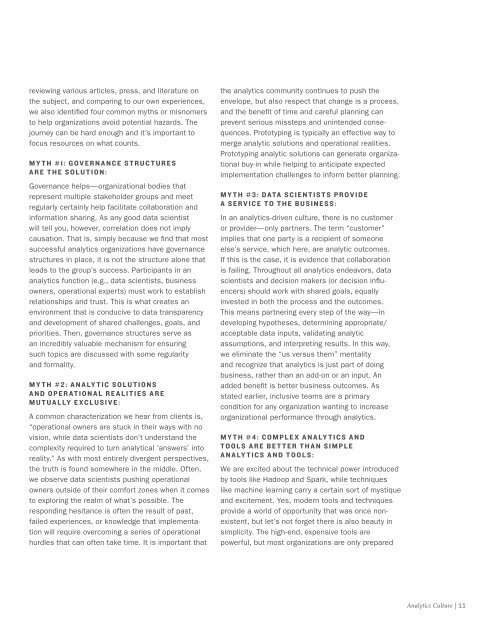Tips for Building a Data Science Capability
1MRbAqC
1MRbAqC
You also want an ePaper? Increase the reach of your titles
YUMPU automatically turns print PDFs into web optimized ePapers that Google loves.
eviewing various articles, press, and literature on<br />
the subject, and comparing to our own experiences,<br />
we also identified four common myths or misnomers<br />
to help organizations avoid potential hazards. The<br />
journey can be hard enough and it’s important to<br />
focus resources on what counts.<br />
MYTH #1: GOVERNANCE STRUCTURES<br />
ARE THE SOLUTION:<br />
Governance helps—organizational bodies that<br />
represent multiple stakeholder groups and meet<br />
regularly certainly help facilitate collaboration and<br />
in<strong>for</strong>mation sharing. As any good data scientist<br />
will tell you, however, correlation does not imply<br />
causation. That is, simply because we find that most<br />
successful analytics organizations have governance<br />
structures in place, it is not the structure alone that<br />
leads to the group’s success. Participants in an<br />
analytics function (e.g., data scientists, business<br />
owners, operational experts) must work to establish<br />
relationships and trust. This is what creates an<br />
environment that is conducive to data transparency<br />
and development of shared challenges, goals, and<br />
priorities. Then, governance structures serve as<br />
an incredibly valuable mechanism <strong>for</strong> ensuring<br />
such topics are discussed with some regularity<br />
and <strong>for</strong>mality.<br />
MYTH #2: ANALYTIC SOLUTIONS<br />
AND OPERATIONAL REALITIES ARE<br />
MUTUALLY EXCLUSIVE:<br />
A common characterization we hear from clients is,<br />
“operational owners are stuck in their ways with no<br />
vision, while data scientists don’t understand the<br />
complexity required to turn analytical ‘answers’ into<br />
reality.” As with most entirely divergent perspectives,<br />
the truth is found somewhere in the middle. Often,<br />
we observe data scientists pushing operational<br />
owners outside of their com<strong>for</strong>t zones when it comes<br />
to exploring the realm of what’s possible. The<br />
responding hesitance is often the result of past,<br />
failed experiences, or knowledge that implementation<br />
will require overcoming a series of operational<br />
hurdles that can often take time. It is important that<br />
the analytics community continues to push the<br />
envelope, but also respect that change is a process,<br />
and the benefit of time and careful planning can<br />
prevent serious missteps and unintended consequences.<br />
Prototyping is typically an effective way to<br />
merge analytic solutions and operational realities.<br />
Prototyping analytic solutions can generate organizational<br />
buy-in while helping to anticipate expected<br />
implementation challenges to in<strong>for</strong>m better planning.<br />
MYTH #3: DATA SCIENTISTS PROVIDE<br />
A SERVICE TO THE BUSINESS:<br />
In an analytics-driven culture, there is no customer<br />
or provider—only partners. The term “customer”<br />
implies that one party is a recipient of someone<br />
else’s service, which here, are analytic outcomes.<br />
If this is the case, it is evidence that collaboration<br />
is failing. Throughout all analytics endeavors, data<br />
scientists and decision makers (or decision influencers)<br />
should work with shared goals, equally<br />
invested in both the process and the outcomes.<br />
This means partnering every step of the way—in<br />
developing hypotheses, determining appropriate/<br />
acceptable data inputs, validating analytic<br />
assumptions, and interpreting results. In this way,<br />
we eliminate the “us versus them” mentality<br />
and recognize that analytics is just part of doing<br />
business, rather than an add-on or an input. An<br />
added benefit is better business outcomes. As<br />
stated earlier, inclusive teams are a primary<br />
condition <strong>for</strong> any organization wanting to increase<br />
organizational per<strong>for</strong>mance through analytics.<br />
MYTH #4: COMPLEX ANALYTICS AND<br />
TOOLS ARE BETTER THAN SIMPLE<br />
ANALYTICS AND TOOLS:<br />
We are excited about the technical power introduced<br />
by tools like Hadoop and Spark, while techniques<br />
like machine learning carry a certain sort of mystique<br />
and excitement. Yes, modern tools and techniques<br />
provide a world of opportunity that was once nonexistent,<br />
but let’s not <strong>for</strong>get there is also beauty in<br />
simplicity. The high-end, expensive tools are<br />
powerful, but most organizations are only prepared<br />
Analytics Culture | 11


